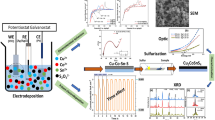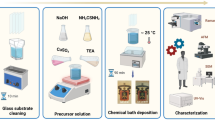Abstract
High purity tin oxide nanopowders have been synthesized by using a solid-state chemical reaction technique with annealing at elevated temperature. The effects of two parameters, specifically by controlling the annealing temperature and kind of alkaline chlorides as precursors, the effect on particle size, morphology and IR spectra of synthesized tin oxide nanopowder were investigated. From the X-ray pattern, the crystal structure of the synthesized powders was confirmed as a tetragonal structure. Based on the recorded FTIR spectrum of SnO2, the IR bands due to SnO2 vibrations and its lattice modes were observed at 625 and 690 cm−1, respectively. In addition, an important characterization peak has been identified at 1,450 cm−1 due to Sn–O–Sn bridges observed only when LiCl was used as precursor. The formation of Sn–O–Sn bridges was confirmed by TGA–DTA analysis. According to the SEM images, it is obvious to notice that the kind of alkaline chlorides as precursors play a dominant role in controlling the morphology of tin oxide nanopowders.






Similar content being viewed by others
References
G. G. Mandayo (2007). Sens. Lett. 5, (2), 341.
S. H. Park, Y. C. Son, W. S. Willis, S. L. Suib, and K. E. Creasy (1998). Chem. Mater. 10, 2389.
A. A. Ansari, P. R. Solanki, and B. D. Malhotra (2009). Sens. Lett. 7, (1), 64.
G. Korotchenkov, V. Brynzari, and S. Dmitriev (1999). Sens. Actuators B 54, 197.
S. I. Rembeza, E. S. Rembeza, T. V. Svistova, and O. I. Borsiakova (2000). Phys. Status Solidi 179, 147.
H. Liu, J. Park, and G. Wang (2010). Sens. Lett. 8, (2), 243.
U. Kersen (2002). Mater. Sci. Forum 633, 386.
F. Li, J. Xu, X. Yu, L. Chen, J. Zhu, Z. Yang, and X. Xin (2002). Sens. Actuators B 81, 165.
Y. M. Zhou, X. Q. Xin, and Chinese (1999). J. Inorg. Chem. 15, 273.
J. B. Wiley and R. B. Kaner (1992). Science 225, 1093.
X. R. Ye, D. J. Jia, J. Q. Yu, X. Q. Xin, and Z. Xue (1999). Adv. Mater. 11, 941.
Y. Wang, Y. Wang, J. Cao, F. Kong, H. Xia, J. Zhang, B. Zhu, S. Wang, and S. Wu (2008). Sens. Actuators B 131, 183.
V. Vorgelegt (2006). Ph.D Thesis, Eberhard Karls University, Tübingen, Germany.
U. Kersen and M. R. Sundberg (2003). J. Electrochem. Soc 150, 129.
Author information
Authors and Affiliations
Corresponding author
Rights and permissions
About this article
Cite this article
Sarabadani, P., Sadeghi, M., Ghasemi, M. et al. Synthesis and Characterization of Tin Oxide Nanoparticles by Solid State Chemical Reaction Method. J Clust Sci 22, 131–140 (2011). https://doi.org/10.1007/s10876-011-0350-1
Received:
Published:
Issue Date:
DOI: https://doi.org/10.1007/s10876-011-0350-1




